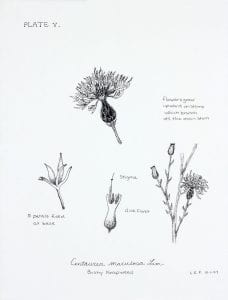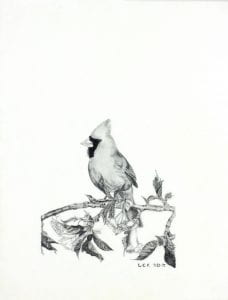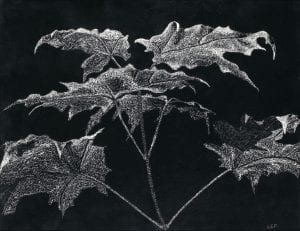The Dandelion
Mission: using watercolor, ink, pencil, dissecting scope, dissecting instruments and whole flowering plants which you have collected to transform a plant called by many an obnoxious lawn weed into a delightful and informing companion!
Observations and Thinking
Collect the long tap-root penetrating deeply into the soil giving the plant access to water when many shallow-rooted plants may be stressed for lack of water.
Examine the array of leaves, with lion-like margin of teeth, called the ‘basal rosette’, demonstrating ‘chirality’, i.e. the array forming a left-hand or right-handed spiral each leaf rotated some 137.5° from the prior leaf. What is the ratio of 137.5° to 222.5°? What is the significance of this ratio?
Observe the hundreds of small flowers or florets perched on the dilated stem tip called the receptacle. Note how the florets change in form from the margin of the flower as you observe more centrally. Are the yellow ‘tongues’ that you are seeing petals or otherwise? Use of the dissecting scope can be helpful here. Note also that the florets are arranged in major (more numerous florets) and minor (less numerous florets) spirals.
Testing your patience, count the number of major and minor spirals. If you have done well and the plant has cooperated you will arrive at a Fibonacci number, i.e. 1, 2, 3, 5, 8, 13, 21, 34, 55 etc. Again chirality is shown with some plants having the major spirals turning left while other plants show the major spirals turning to the right. Who was Fibonacci of Pisa and what major contribution did he make to the Western World in 1202?
Select any two numbers and add them as is done in the Fibonacci series to make ten additions. Now take the last number in your series and divide it by the last to next number in your series to establish a proportion. Strange! This is the Divine Proportion as used by hundreds of different graphic artists in their paintings, sculpture, pottery and other fine works. Think of Phidias and our current use of the Greek Letter Phi for the ratio. Realize as well that the application of the ratio by plants in photosynthesis helps to feed the living world more efficiently. Can you explain this?
Now examine the florets closely, again using the scope dissecting them with teasing needles to best see their structure. Can you find the anthers of the five stamens forming a tube through which the pistil rises? At the base of this array find the pappus which become the ‘parachute’ that can carry the seed (achene) miles away in a brisk wind. If the mature fruiting heads are available enjoy their exquisite structure using the scope. Despite the presence of the needed apparatus, as you have seen, remarkably many dandelion plants escape sexual intercourse by means of ‘apomixis’. Look the word up.
Illustrative Mission
Illustrate the above ideas toward teaching your observers about the origin of the Latin name, adaptive value of tap roots, ‘division of labor’ by various florets, chirality, the golden section and transformation of calyx or pappus into aeronautical beauty- toward convincing them that the common dandelion, Taraxcum officinale, can spangle your lawn rather than strangle it. Many great artists have found delight in this wondrous plant AND you can also use the leaves as a nutritious addition to your salads.
Select any image below to begin slideshow,
scroll down and check “full size” to see the image full scale,
select X in upper right corner to return to this page.
Please use the menu on the right to navigate through course topics.





